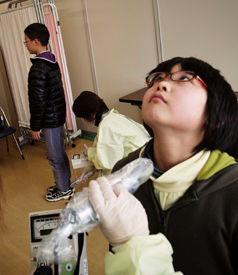There are a number of ways to gauge your dietary carbohydrate exposure and its physiologic consequences.
One of my favorite ways is to do fingerstick blood sugars for a
one-hour postprandial glucose. I like this because it provides real-time feedback on the glucose consequences of your last meal. This can pinpoint problem areas in your diet.
Another way is to measure
small LDL particles. Because small LDL particles are created through a cascade that begins with carbohydrate consumption, measuring them provides an index of both carbohydrate exposure and sensitivity. Drawback: Getting access to the test.
For many people, the most practical and widely available gauge of carbohydrate intake and sensitivity is your hemoglobin A1c, or HbA1c.
HbA1c reflects the previous 60 to 90 days blood sugar fluctuations, since hemoglobin is irreversibly glycated by blood glucose. (Glycation is also the phenomenon responsible for formation of cataracts from glycation of lens proteins, kidney disease, arthritis from glycation of cartilage proteins, atherosclerosis from LDL glycation and components of the arterial wall, and many other conditions.)
HbA1c of a primitive hunter-gatherer foraging for leaves, roots, berries, and hunting for elk, ibex, wild boar, reptiles, and fish: 4.5% or less.
HbA1c of an average American: 5.2% (In the population I see, however, it is typically 5.6%, with many 6.0% and higher.)
HbA1c of diabetics: 6.5% or greater.
Don't be falsely reassured by not having a HbA1c that meets "official" criteria for diabetes. A HbA1c of 5.8%, for example, means that many of the complications suffered by diabetics--kidney disease, heightened risk for atherosclerosis, osteoarthritis, cataracts--are experienced at nearly the same rate as diabetics.
With our wheat-free, cornstarch-free, sugar-free diet, we have been aiming to reduce HbA1c to 4.8% or less, much as if you spent your days tracking wild boar.

Comment: For more information about the connection between diet and hyperactivity in children read the following articles:
Study: Cutting Out Suspect Foods Could Help Calm ADHD Children Study: Western Diet Link to ADHD Do Synthetic Food Colors Cause Hyperactivity?
Food Dyes Linked to Hyper Kids, Group Asks FDA to Ban